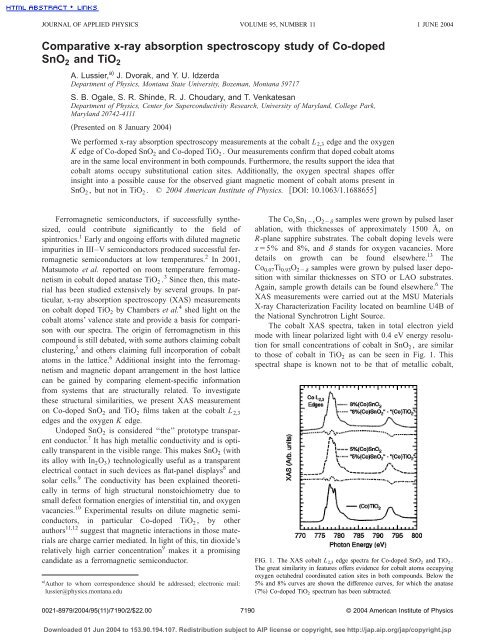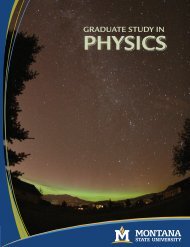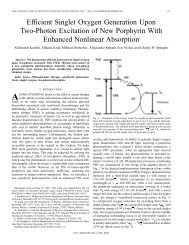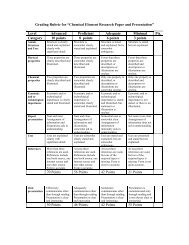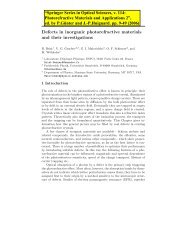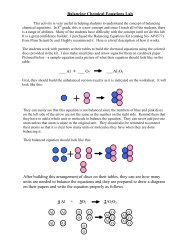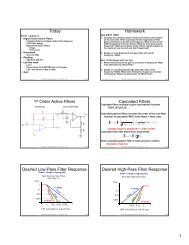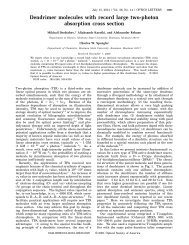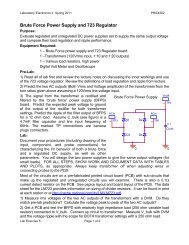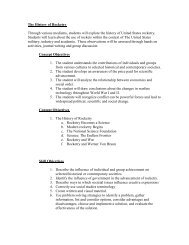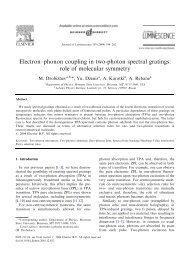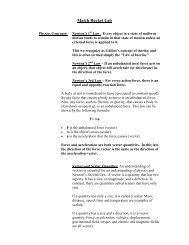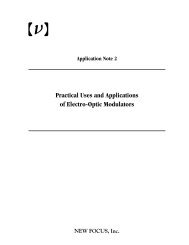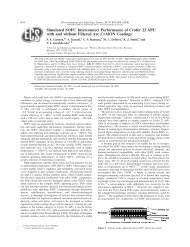Comparative x-ray absorption spectroscopy study of Co-doped ...
Comparative x-ray absorption spectroscopy study of Co-doped ...
Comparative x-ray absorption spectroscopy study of Co-doped ...
Create successful ePaper yourself
Turn your PDF publications into a flip-book with our unique Google optimized e-Paper software.
JOURNAL OF APPLIED PHYSICS VOLUME 95, NUMBER 11 1 JUNE 2004<br />
<strong><strong>Co</strong>mparative</strong> x-<strong>ray</strong> <strong>absorption</strong> <strong>spectroscopy</strong> <strong>study</strong> <strong>of</strong> <strong>Co</strong>-<strong>doped</strong><br />
SnO 2 and TiO 2<br />
A. Lussier, a) J. Dvorak, and Y. U. Idzerda<br />
Department <strong>of</strong> Physics, Montana State University, Bozeman, Montana 59717<br />
S. B. Ogale, S. R. Shinde, R. J. Choudary, and T. Venkatesan<br />
Department <strong>of</strong> Physics, Center for Superconductivity Research, University <strong>of</strong> Maryland, <strong>Co</strong>llege Park,<br />
Maryland 20742-4111<br />
Presented on 8 January 2004<br />
We performed x-<strong>ray</strong> <strong>absorption</strong> <strong>spectroscopy</strong> measurements at the cobalt L 2,3 edge and the oxygen<br />
K edge <strong>of</strong> <strong>Co</strong>-<strong>doped</strong> SnO 2 and <strong>Co</strong>-<strong>doped</strong> TiO 2 . Our measurements confirm that <strong>doped</strong> cobalt atoms<br />
are in the same local environment in both compounds. Furthermore, the results support the idea that<br />
cobalt atoms occupy substitutional cation sites. Additionally, the oxygen spectral shapes <strong>of</strong>fer<br />
insight into a possible cause for the observed giant magnetic moment <strong>of</strong> cobalt atoms present in<br />
SnO 2 , but not in TiO 2 . © 2004 American Institute <strong>of</strong> Physics. DOI: 10.1063/1.1688655<br />
Ferromagnetic semiconductors, if successfully synthesized,<br />
could contribute significantly to the field <strong>of</strong><br />
spintronics. 1 Early and ongoing efforts with diluted magnetic<br />
impurities in III–V semiconductors produced successful ferromagnetic<br />
semiconductors at low temperatures. 2 In 2001,<br />
Matsumoto et al. reported on room temperature ferromagnetism<br />
in cobalt <strong>doped</strong> anatase TiO 2 . 3 Since then, this material<br />
has been studied extensively by several groups. In particular,<br />
x-<strong>ray</strong> <strong>absorption</strong> <strong>spectroscopy</strong> XAS measurements<br />
on cobalt <strong>doped</strong> TiO 2 by Chambers et al. 4 shed light on the<br />
cobalt atoms’ valence state and provide a basis for comparison<br />
with our spectra. The origin <strong>of</strong> ferromagnetism in this<br />
compound is still debated, with some authors claiming cobalt<br />
clustering, 5 and others claiming full incorporation <strong>of</strong> cobalt<br />
atoms in the lattice. 6 Additional insight into the ferromagnetism<br />
and magnetic dopant arrangement in the host lattice<br />
can be gained by comparing element-specific information<br />
from systems that are structurally related. To investigate<br />
these structural similarities, we present XAS measurement<br />
on <strong>Co</strong>-<strong>doped</strong> SnO 2 and TiO 2 films taken at the cobalt L 2,3<br />
edges and the oxygen K edge.<br />
Un<strong>doped</strong> SnO 2 is considered ‘‘the’’ prototype transparent<br />
conductor. 7 It has high metallic conductivity and is optically<br />
transparent in the visible range. This makes SnO 2 with<br />
its alloy with In 2 O 3 ) technologically useful as a transparent<br />
electrical contact in such devices as flat-panel displays 8 and<br />
solar cells. 9 The conductivity has been explained theoretically<br />
in terms <strong>of</strong> high structural nonstoichiometry due to<br />
small defect formation energies <strong>of</strong> interstitial tin, and oxygen<br />
vacancies. 10 Experimental results on dilute magnetic semiconductors,<br />
in particular <strong>Co</strong>-<strong>doped</strong> TiO 2 , by other<br />
authors 11,12 suggest that magnetic interactions in those materials<br />
are charge carrier mediated. In light <strong>of</strong> this, tin dioxide’s<br />
relatively high carrier concentration 9 makes it a promising<br />
candidate as a ferromagnetic semiconductor.<br />
a Author to whom correspondence should be addressed; electronic mail:<br />
lussier@physics.montana.edu<br />
The <strong>Co</strong> x Sn 1x O 2 samples were grown by pulsed laser<br />
ablation, with thicknesses <strong>of</strong> approximately 1500 Å, on<br />
R-plane sapphire substrates. The cobalt doping levels were<br />
x5% and 8%, and stands for oxygen vacancies. More<br />
details on growth can be found elsewhere. 13 The<br />
<strong>Co</strong> 0.07 Ti 0.93 O 2 samples were grown by pulsed laser deposition<br />
with similar thicknesses on STO or LAO substrates.<br />
Again, sample growth details can be found elsewhere. 6 The<br />
XAS measurements were carried out at the MSU Materials<br />
X-<strong>ray</strong> Characterization Facility located on beamline U4B <strong>of</strong><br />
the National Synchrotron Light Source.<br />
The cobalt XAS spectra, taken in total electron yield<br />
mode with linear polarized light with 0.4 eV energy resolution<br />
for small concentrations <strong>of</strong> cobalt in SnO 2 , are similar<br />
to those <strong>of</strong> cobalt in TiO 2 as can be seen in Fig. 1. This<br />
spectral shape is known not to be that <strong>of</strong> metallic cobalt,<br />
FIG. 1. The XAS cobalt L 2,3 edge spectra for <strong>Co</strong>-<strong>doped</strong> SnO 2 and TiO 2 .<br />
The great similarity in features <strong>of</strong>fers evidence for cobalt atoms occupying<br />
oxygen octahedral coordinated cation sites in both compounds. Below the<br />
5% and 8% curves are shown the difference curves, for which the anatase<br />
7% <strong>Co</strong>-<strong>doped</strong> TiO 2 spectrum has been subtracted.<br />
0021-8979/2004/95(11)/7190/2/$22.00 7190<br />
© 2004 American Institute <strong>of</strong> Physics<br />
Downloaded 01 Jun 2004 to 153.90.194.107. Redistribution subject to AIP license or copyright, see http://jap.aip.org/jap/copyright.jsp
J. Appl. Phys., Vol. 95, No. 11, Part 2, 1 June 2004 Lussier et al.<br />
7191<br />
FIG. 2. The XAS oxygen K edge spectra <strong>of</strong> <strong>Co</strong>-<strong>doped</strong> SnO 2 and TiO 2 .The<br />
t 2g band in the SnO 2 samples is completely suppressed. The t 2g directionality<br />
is demonstrated by the feature suppression with changing photon incidence<br />
direction.<br />
which precludes extensive metallic clustering, at least to our<br />
probing depth <strong>of</strong> a few hundred angstroms. The cobalt L 2,3<br />
edge spectra <strong>of</strong> the <strong>Co</strong>-<strong>doped</strong> SnO 2 , and anatase TiO 2<br />
samples all share the same general features with only very<br />
slight differences in relative peak intensities. The strong<br />
similarities in the spectra can be seen from the difference<br />
spectra between the SnO 2 and TiO 2 spectra included on Fig.<br />
1. The similarity we observe in XAS spectral shapes is indicative<br />
<strong>of</strong> a similar local environment structural and chemical<br />
and oxidation state for cobalt atoms, regardless <strong>of</strong><br />
whether they are <strong>doped</strong> in TiO 2 or SnO 2 . The cation substitutional<br />
sites in both compounds have the same distorted<br />
oxygen octahedral coordination 14,15 suggesting that cobalt atoms<br />
sit at the substitutional site, in agreement with cobalt<br />
K-edge XAS <strong>of</strong> <strong>Co</strong>-<strong>doped</strong> TiO 2 samples by Chambers<br />
et al. 16 Our L-edge spectra indicate that cobalt atoms are<br />
most likely substitutional in SnO 2 also.<br />
A marked difference is that cobalt <strong>doped</strong> in SnO 2 leads<br />
to giant magnetic moments <strong>of</strong> the cobalt atoms, 11 which is<br />
not observed for cobalt in TiO 2 . Although the cobalt atoms<br />
have analogous nearest neighbor coordination in both compounds,<br />
we detect an important difference in their magnetic<br />
behavior. The oxygen spectra hint to a possible explanation.<br />
To reiterate, the ferromagnetism in these dilute compounds<br />
is generally accepted to be charge carrier mediated.<br />
Additionally, the charge carrier density is determined by<br />
oxygen vacancies, 17 and therefore closely associated with<br />
oxygen. If the electronic states <strong>of</strong> oxygen in TiO 2 and SnO 2 ,<br />
which are revealed in the XAS spectra, are significantly different,<br />
we might expect the magnetic properties <strong>of</strong> the compound<br />
will also be different. As can be seen in Fig. 2, although<br />
the cobalt spectra are similar, the oxygen spectra are<br />
dramatically different. Note that oxygen atoms in TiO 2 or<br />
SnO 2 have only about 5% <strong>of</strong> their cation neighbors replaced<br />
by cobalt. The XAS spectra <strong>of</strong> oxygen are therefore virtually<br />
unaffected by the cobalt, and the obvious spectral differences<br />
reflect the different properties <strong>of</strong> the host lattice. The first<br />
peak at 530.5 eV in the TiO 2 oxygen spectrum represents the<br />
t 2g band. It is a sharp feature related to directional bonds<br />
and is completely suppressed in SnO 2 . The bond directionality<br />
is made evident by comparison <strong>of</strong> the spectra taken on<br />
a <strong>Co</strong>-<strong>doped</strong> TiO 2 sample with the photon incident beam normal<br />
to the surface, or at 60° with respect to the sample<br />
normal. The t 2g feature is partly suppressed in the latter case.<br />
These differences indicate differences in the host oxide’s<br />
electronic properties, which would in turn affect the carrier<br />
mediated magnetic interactions and possibly lead to giant<br />
cobalt magnetic moments in SnO 2 . Among the proposed explanations<br />
for the giant magnetic moment is unquenching <strong>of</strong><br />
the cobalt orbital moments 11 and our observation <strong>of</strong> the electronic<br />
variations for oxygen could be related to quenching.<br />
Another possible explanation lies in spin transfer on neighboring<br />
Sn atoms, a possibility that we are currently investigating.<br />
To summarize, our cobalt L 2,3 XAS measurements allowed<br />
us to demonstrate that <strong>doped</strong> cobalt atoms are in the<br />
same local environment in SnO 2 as in TiO 2 . These measurements<br />
also corroborate other published results that show cobalt<br />
atoms occupy substitutional titanium sites in TiO 2 . Additionally,<br />
XAS measurements at the oxygen K edge reveal<br />
vastly different oxygen electronic states in the two compounds.<br />
In light <strong>of</strong> the role played by oxygen vacancies in<br />
charge carrier generation, and by virtue <strong>of</strong> the proposed role<br />
played by charge carriers in the magnetic behavior <strong>of</strong> these<br />
materials, the differing oxygen states suggest an explanation<br />
for the giant magnetic moment observed in SnO 2 but absent<br />
in TiO 2 .<br />
This work is supported by the National Science Foundation<br />
and the National Synchrotron Light Source is supported<br />
by the Department <strong>of</strong> Energy. Additionally, we would like to<br />
acknowledge support under NSF-MRSEC Grant No. DMR<br />
00-80008 and DARPA SpinS Grant No. N000140210962.<br />
1 G. Schmidt and L. W. Molenkamp, J. Appl. Phys. 89, 7443 2001.<br />
2 H. Ohno, Science 281, 951 1998.<br />
3 Y. Matsumoto, M. Murakami, T. Shono, T. Hasegawa, T. Fukumura, M.<br />
Kawasaki, P. Ahmet, T. Chikyow, S.-y. Koshihara, and H. Koinuma, Science<br />
291, 854 2001.<br />
4 S. A. Chambers et al., Appl. Phys. Lett. 79, 3467 2001.<br />
5 J.-Y. Kim et al., Phys. Rev. Lett. 90, 017401 2003.<br />
6 S. R. Shinde, S. B. Ogale, S. Das Sarma, J. R. Simpson, H. D. Drew, S. E.<br />
L<strong>of</strong>land, C. Lanci, J. P. Buban, and N. D. Browning, Phys. Rev. B 67,<br />
115211 2003.<br />
7 Ç. Kiliç and A. Zunger, Phys. Rev. Lett. 88, 095501 2002.<br />
8 B. G. Lewis and D. C. Paine, MRS Bull. 25, 222000.<br />
9 H. L. Hartnagel, A. L. Jain, and C. Jagadish, Semiconducting Transparent<br />
Thin Films IOP, Bristol, 1995.<br />
10 Ç. Kiliç and A. Zunger, Phys. Rev. Lett. 88, 095501 2002.<br />
11 M. Berciu and R. N. Bhatt, Phys. Rev. Lett. 87, 107203 2001; J.König,<br />
H. Lin, and A. H. MacDonald, ibid. 84, 5628 2000.<br />
12 S. A. Chambers, Mater., Today 34, April 2002.<br />
13 S. B. Ogale et al., Phys. Rev. Lett. 91, 077205 2003.<br />
14 L. Soriano, P. P. Ahonen, E. Kauppinen, J. Gomez-Garcia, C. Morant, F. J.<br />
Palomares, M. Sanchez-Agudo, P. R. Bressler, and J. M. Sanz, Monatsch.<br />
Chem. 133, 849 2002.<br />
15 F. M. F. de Groot, J. Faber, J. J. M. Michiels, M. T. Czyzyk, M. Abbate,<br />
and J. C. Fuggle, Phys. Rev. B 48, 2074 1993-II.<br />
16 S. A. Chambers, S. M. Heald, and T. Droubay, Phys. Rev. B 67,<br />
100401R 2003.<br />
17 S. A. Chambers, C. M. Wang, S. Thevuthasan, T. Droubay, D. E. Mc-<br />
Cready, A. S. Lea, V. Shutthanandan, and C. F. Windisch, Jr., Thin Solid<br />
Films 418, 197 2002.<br />
Downloaded 01 Jun 2004 to 153.90.194.107. Redistribution subject to AIP license or copyright, see http://jap.aip.org/jap/copyright.jsp


